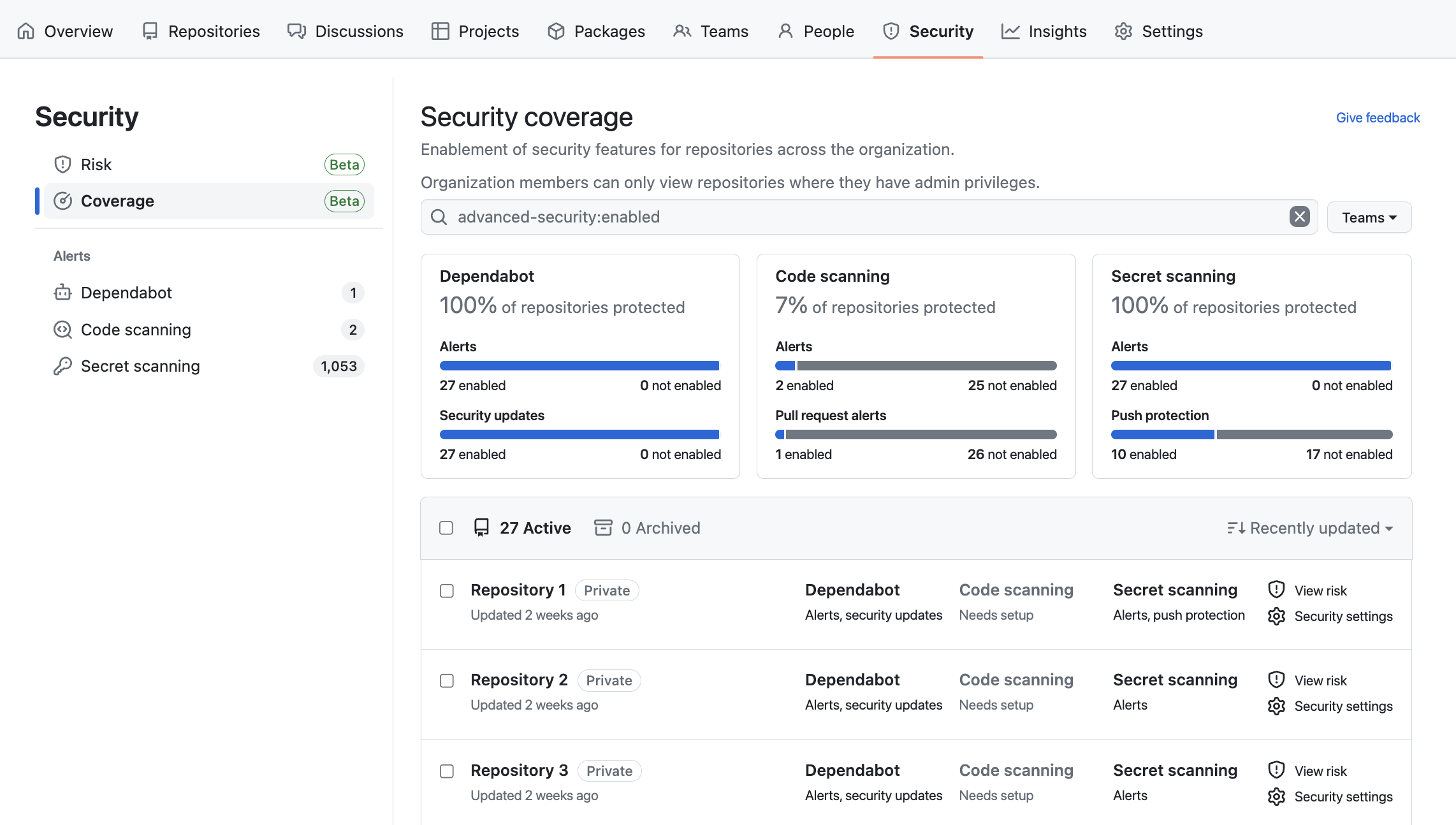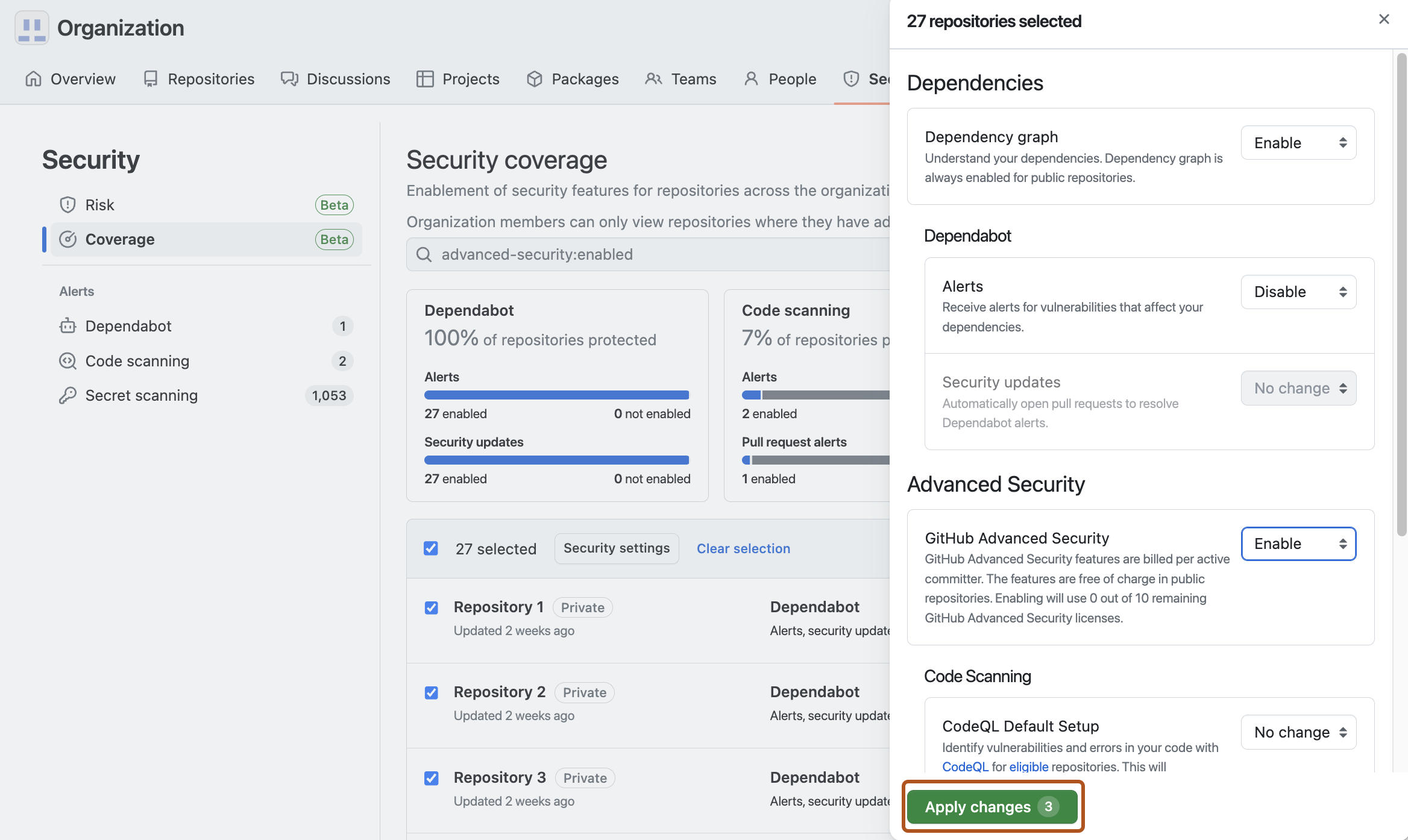About configuring default setup at scale
With default setup for code scanning, you can quickly secure code in repositories across your organization.
You can enable code scanning for all repositories in your organization that are eligible for default setup. After enabling default setup, the code written in CodeQL-supported languages in repositories in the organization will be scanned:
- On each push to the repository's default branch, or any protected branch. For more information on protected branches, see About protected branches.
- When creating or committing to a pull request based against the repository's default branch, or any protected branch, excluding pull requests from forks.
- On a weekly schedule.
For more information, see Configuring default setup for all eligible repositories in an organization.
You can also use security overview to find a set of repositories in your organization and enable or disable default setup for all of them at the same time. For more information, see Configuring default setup for a subset of repositories in an organization.
For repositories that are not eligible for default setup, you can configure advanced setup at the repository level, or at the organization level using a script. For more information, see Configuring advanced setup for code scanning with CodeQL at scale.
Eligible repositories for CodeQL default setup at scale
A repository must meet all the following criteria to be eligible for default setup, otherwise you need to use advanced setup.
- Advanced setup for code scanning is not already enabled.
- GitHub Actions are enabled.
- GitHub Advanced Security is enabled.
We recommend enabling default setup for eligible repositories if there is any chance the repositories will include at least one CodeQL-supported language in the future. If you enable default setup on a repository that does not include any CodeQL-supported languages, default setup will not run any scans or use any GitHub Actions minutes. If CodeQL-supported languages are added to the repository's default branch, default setup will automatically begin scanning CodeQL-supported languages and using GitHub Actions minutes. For more information on CodeQL-supported languages, see About code scanning with CodeQL.
Note
Configuring default setup for all repositories in an organization through your organization's settings page will not override existing configurations of default setup. However, configuring default setup on a subset of repositories in an organization through security overview will override existing configurations of default setup on those repositories.
About adding languages to an existing default setup configuration
If the code in a repository changes to include a CodeQL-supported language, GitHub will automatically update the code scanning configuration to include the new language. If code scanning fails with the new configuration, GitHub will resume the previous configuration automatically so the repository does not lose code scanning coverage.
Configuring default setup for all eligible repositories in an organization
Through the "Code security and analysis" page of your organization's settings, you can enable default setup for all eligible repositories in your organization. For more information on repository eligibility, see Eligible repositories for CodeQL default setup at scale.
- In the upper-right corner of GitHub, select your profile photo, then click Your organizations**.
- Next to the organization, click Settings.
- In the "Security" section of the sidebar, click Code security and analysis.
- Click Enable all next to "Code scanning".
- In the "Query suites" section of the "Enable code scanning default setup" dialog box displayed, select the query suite your configuration of default setup will run. For more information, see CodeQL query suites.
- To enable your configuration of default setup, click Enable for eligible repositories.
- Optionally, to recommend the "Extended" query suite throughout your organization when enabling default setup, select "Recommend the extended query suite for repositories enabling default setup."
Note
- If you disable CodeQL code scanning for all repositories this change is not reflected in the coverage information shown in security overview for the organization. The repositories will still appear to have code scanning enabled in the "Security Coverage" view.
- Enabling code scanning for all eligible repositories in an organization will not override existing code scanning configurations. For information on configuring default setup with different settings for specific repositories, see Configuring default setup for code scanning.
- Enabling default setup for all eligible repositories in an organization includes eligible repositories without CodeQL-supported languages. If a CodeQL-supported language is later added to one of these repositories, default setup will begin scanning that repository and consuming GitHub Actions minutes.
Extending CodeQL coverage in default setup
Through your organization's security settings page, you can extend coverage in default setup using model packs for all eligible repositories in your organization. For more information, see Editing your configuration of default setup.
Configuring default setup for a subset of repositories in an organization
Through security overview for your organization, you can find eligible repositories for default setup, then enable default setup across each of those repositories simultaneously. For more information on repository eligibility, see Eligible repositories for CodeQL default setup at scale.
Finding repositories that are eligible for default setup
-
On GitHub, navigate to the main page of the organization.
-
Under your organization name, click Security.

-
In the sidebar, click Coverage to display the "Security coverage" view.

-
In the search bar, enter one of the following queries:
code-scanning-default-setup:eligible is:publicshows repositories that have languages suitable for default setup and are eligible because they are visible to the public.code-scanning-default-setup:eligible advanced-security:enabledshows private or internal repositories that have languages suitable for default setup and are eligible because they have GitHub Advanced Security enabled.code-scanning-default-setup:eligible is:private,internal advanced-security:not-enabledshows private or internal repositories that have languages suitable for default setup but do not have GitHub Advanced Security enabled. Once you enable GitHub Advanced Security for these repositories, they can also be added to default setup.
You can select all of the displayed repositories, or a subset of them, and enable or disable default setup for code scanning for them all at the same time. For more information, see step 5 of Configuring default setup at scale for multiple repositories in an organization.
Configuring default setup at scale for multiple repositories in an organization
-
On GitHub, navigate to the main page of the organization.
-
Under your organization name, click Security.

-
In the sidebar, click Coverage to display the "Security coverage" view.

-
You can use the search bar to narrow down visible repositories in the "Security coverage" view based on name, or on the enablement status of security features. For example, to filter for repositories that are eligible for default setup and do not currently have default setup enabled, search for
code-scanning-default-setup:eligible. -
In the list of repositories, select each repository you want to enable code scanning for.
- To enable code scanning for all repositories on the page, select the checkbox next to NUMBER Active.
- To enable code scanning for all repositories that match the current search, select the checkbox next to NUMBER Active, then click Select all NUMBER repos.
-
Click Security settings next to NUMBER selected.
-
In the side panel, in the "CodeQL Default Setup" section, select No change, then click Enable.
-
Optionally, to choose a different query suite than your organization's default query suite, select Query suite: SUITE NAME, then click the query suite your configuration of default setup should use. For more information, see CodeQL query suites.
-
To confirm the enablement of code scanning for the selected repositories, click Apply changes NUMBER. Alternatively, to select or deselect more repositories for code scanning enablement, click to close the panel without applying your changes.
Note
- Enabling code scanning for multiple repositories in an organization using security overview will override any existing code scanning configurations for the selected repositories, including any previous query suite selections and workflows for advanced setups.
- You can enable default setup for eligible repositories that do not contain CodeQL-supported languages. If a CodeQL-supported language is later added to one of these repositories, default setup will begin scanning that repository and consuming GitHub Actions minutes.

If you're blocked from enabling code scanning due to an enterprise policy, you will still be able to see the affected repository in the "Security Coverage" view and access the side panel from the Security settings button. However, you will see a message in the side panel indicating that you cannot enable code scanning for the selected repositories. For more information about enterprise policies, see Enforcing policies for code security and analysis for your enterprise.
Configuring merge protection for all repositories in an organization
You can use rulesets to prevent pull requests from being merged when one of the following conditions is met:
-
A required tool found a code scanning alert of a severity that is defined in a ruleset.
-
A required code scanning tool's analysis is still in progress.
-
A required code scanning tool is not configured for the repository.
For more information, see Set code scanning merge protection. For more general information about rulesets, see About rulesets.